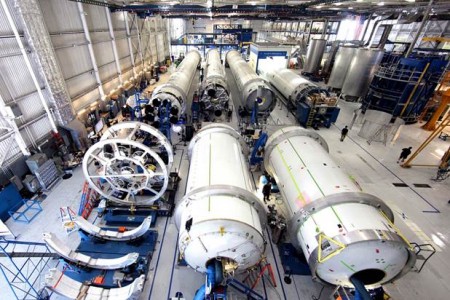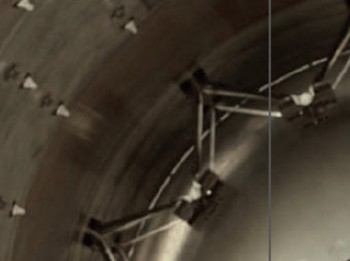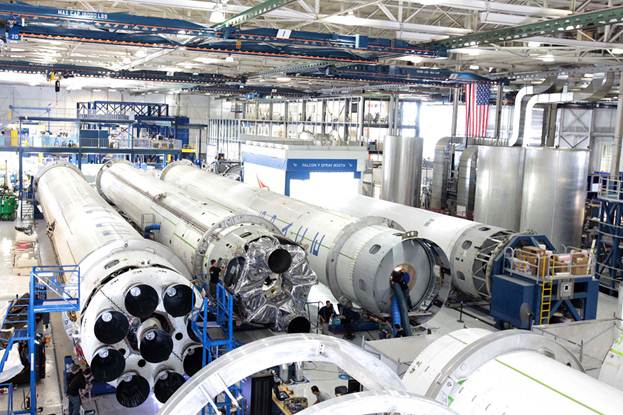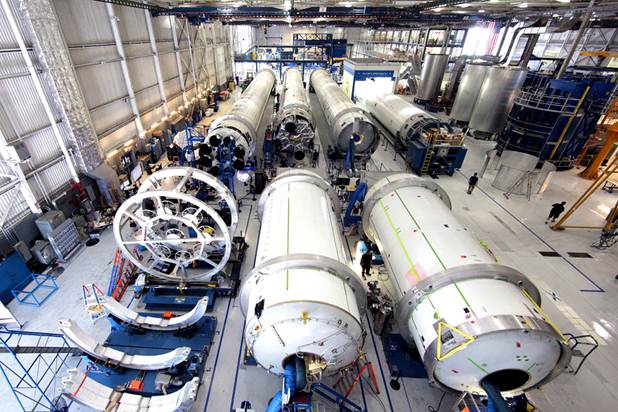July 21, 2015 – In an update sent out by the company yesterday, SpaceX described the events pertaining to the 19th launch of its Falcon 9 rocket which blew up in a second stage mishap at 2 minutes, 19 seconds into the flight on July 2, 2015. In a 0.893 second moment Falcon 9 telemetry indicated excess pressure in its second stage leading to a breach in the helium system and the destruction of the rocket.
Preliminary analysis so far indicates a failure of a piece of hardware, an internal strut, one of many used to support the helium bottles that are located inside the liquid oxygen tank within the second stage (see picture of the struts in the second stage tank below).
Similar struts have been used in all Falcon 9 rocket launch vehicles and have been tested to withstand forces of 44,482.216 Newtons ( 10,000 pounds). But in this event the strut failed at 8,896.4432 Newtons (2,000 pounds-force), a mere 20% of designed stress tolerance.
There is some interesting telemetry from the flight data as reported on NASA’s Spaceflight website. Initially at the point of the strut failure it shows a decrease in helium pressure followed by a restoration to normal pressure. What engineers conjecture – the strut failed causing the helium bottle to brake free temporarily pinching a gas line which appeared to restore pressure to normal. After that with the bottle loose inside the second stage, helium escaped in sufficient quantity to cause overpressure and the loss of stage integrity.
In a review of the manufacturing process of the faulty second stage strut no visible flaws appeared. But clearly something in the materials failed and SpaceX went back to test similar struts and found the potential for similar material weakness.
Even though these findings are preliminary, SpaceX is discontinuing the use of this subcontracted manufactured strut in all its Falcon 9 rocket assemblies (see some shots of the SpaceX production line in the two images provided below).
As part of the review process SpaceX has put in place an increase in the number of hardware quality audits it conducts through all aspects of its production and assembly process. When the final investigation report comes out within the next few months SpaceX plans to resume its commercial launch program for NASA, the U.S. military, and a number of corporate customers. The launch failure is not expected to impact the plans for SpaceX to use its Dragon capsule on top of a Falcon 9 to send human missions to the International Space Station by 2017. NASA recently announced first crew launch dates.
Putting the rocket failure in perspective. The best launch success rates of space programs, whether from a public agency like NASA and ESA, or from private companies like Orion and SpaceX, include failures. One shuttle launch proved deadly for its crew. Another failed on reentry causing the death of a second crew. Even during NASA’s string of human launches with Mercury, Gemini and Apollo there were numerous snafus many coming close to loss of crew incidents. This SpaceX accident happened in a supply mission. The Orion Antares accident of October 2014 was also a supply mission. Several Russian Progress supply missions have gone awry.
As I have said before, space isn’t easy and we humans remain on a steep learning curve.





















